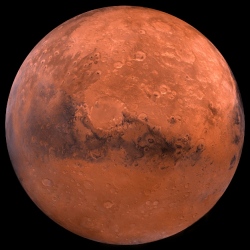
NASA have discovered that three powerful dust storms which occur each Martian year could pose a hazard to astronauts undertaking a mission. The discovery also represents an opportunity for planetary scientists to gain an insight regarding the processes at work in the tenuous Martian atmosphere.
Dust storms on Mars are ordinarily relatively small scale, short-lived affairs, measuring on average 1,200 miles (2,000 km) across, and observed to dissipate within a few days of forming. However, sometimes these weather systems can evolve into larger regional storms, which have been known to last up to three weeks.
The largest of these storms can engulf most of the barren planet’s southern hemisphere. Since NASA established its orbital presence around Mars in 1997, two exceptionally powerful dust storms have succeeded in shrouding the entire planet.
The recent study, which made use of atmospheric temperature readings collected by NASA’s Mars Reconnaissance Orbiter and the Mars Global Surveyor spacecraft, has identified storm patterns in Mars’ annual weather cycle. The research identifies three distinct storms that have been observed to take place on each of the last six Martian years.
Temperature was found to be the optimum means of tracking storm activity, as dust carried into the Martian atmosphere by the Red Planet’s winds intercepts and absorbs the sunlight. By tracking the warmth signature of the dusty air, which can be up to 63º F (35º C) warmer than its dust-free counterpart in a band 16 miles (25 km) above the Martian surface, the researchers were able to track the locations and intensity of the storms.
"When we look at the temperature structure instead of the visible dust, we finally see some regularity in the large dust storms," states David Kass of NASA’s Jet Propulsion Laboratory, Pasadena, California, and lead author of paper on the findings. "Recognizing a pattern in the occurrence of regional dust storms is a step toward understanding the fundamental atmospheric properties controlling them."
Each of the storms appears around the same time, and forms in the same region each Martian year. The first of the storms, imaginatively designated Type A, originates as a smaller storm near the north pole during the northern autumn. As it travels south into the spring conditions prevailing in the southern hemisphere, the winds are energized, lifting a greater amount of dust high into the Red Planet’s atmosphere, allowing the storm to expand into a regional weather event.
The Type B storm initially forms in the south polar region before travelling north prior to the onset of summer in the southern hemisphere. Multiple instances of the storm could give rise to a wide spread haze. The final storm – referred to as Type C – is the most unpredictable of the three, varying significantly in power from year to year. Originating in the northern hemisphere during the local winter, the storms sweep south, where they behave the same as Type A storms.
The ability to predict these vast Martian weather events could have a significant impact on the planning of future manned and unmanned exploration missions to the Red Planet. Regional dust storms have the potential to significantly reduce the output of solar cells, such as those currently powering the Curiosity and Opportunity rovers by coating their sunlight collecting surfaces.
Furthermore, the electrostatic qualities of the storms could interfere with vital equipment, while the sheer density of the dust particles works to dramatically lower visibility for astronauts. The ability to plan around, or simply prepare for these weather events will allow for longer-lasting, safer missions to the Martian surface
